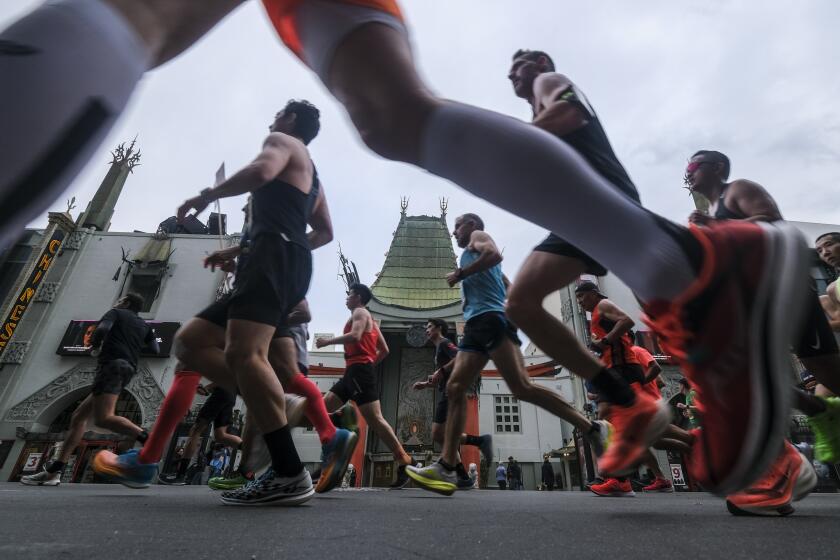- Share via
Being tasked with re-creating Billie Holiday’s iconic looks in “The United States vs. Billie Holiday” was a challenge for costume designer Paolo Nieddu, both because director Lee Daniels’ biopic required so many costume changes and because there was a pressure to get the history right. Ultimately, Nieddu, who previously collaborated with Daniels on “Empire,” determined that the film’s aesthetic was an imagined take on Holiday rather than a definitive reality.
“I knew Billie has a lot of fans, and there are a lot of people who might say, ‘That’s not realistic,’” says Nieddu, who had eight weeks of prep time before production in Montreal in late 2019. “But we created our Billie. It’s not an A&E ‘Biography’ documentary. This is ‘Lee Daniels does Billie Holiday,’ and that’s where I had to take my mind and focus. It became our interpretation of this time.”
The film centers on a specific era in Holiday’s life and career as she’s under investigation by the U.S. government for drug use. Nieddu pulled dozens of photographs of Holiday and researched what was happening both in Harlem and in the general fashion scene during the late 1940s. He and Daniels put together a look-book of photos of Holiday from different moments in her life to use as historical reference as well as inspiration for scenes that weren’t documented.
“Even if something wasn’t a direct reference where we took it out of a photograph, we would still make sure the essence of it was similar,” Nieddu notes. “For a montage look, we might not have time to build a dress based on a photo, but we would find something that gave that feeling.”
Because the film spans several years and includes a few montage sequences, Holiday, played by Andra Day, needed almost 70 different outfits. Some, such as her performance gowns, were custom designs; other outfits were pulled together from existing vintage pieces sourced from both rental houses and shops. Thanks to a connection from Daniels, Prada came on board to create nine custom designs, including six gowns and a suit.
“It’s almost like how with ‘Breakfast at Tiffany’s’ Givenchy worked with the filmmakers,” Nieddu says. “The pieces we did were inspired by real historical pictures of Billie, and we got to reinterpret them. I used archive pieces of Prada. I’d find a photo of Billie, and we’d want to do this dress, and I’d go through the Prada archive to find pieces that were similar — and it didn’t matter if they were from 2017 or the 2019 resort collection. That was the amazing thing — that I could say, ‘I want this sleeve from this dress in this collection, and can you put it on the body of this dress and make it go to the floor and make it yellow?’ It was literally custom Prada.”
One of the key looks in the film is the sparkling black gown, long white gloves and white gardenia hairpin Holiday wore during her Carnegie Hall performance. Nieddu based the look on a grainy photograph of the actual night but added beading and side panels to give the dress more movement. It’s an example of Holiday’s iconic style coming from her drug addiction, lending the glitz a sense of heartbreak.
“She did wear gardenias,” Nieddu confirms. “There’s speculation that she stabbed herself putting them in [her hair] because she was high, and then she continued to wear them. Same with the gloves — she wore those gloves because of her [needle] track marks and to hide them. These elements that became style were really out of tragedy. They became these elements of her look based out of something that wasn’t just for the glamour.”
Although the male characters were slightly less ritzy, Nieddu also went custom for the characters of Jimmy Fletcher (Trevante Rhodes) and Harry Anslinger (Garrett Hedlund), creating 30 suits in all for them. The evolution of Rhodes’ character is apparent in his looks, which become looser and cooler the longer he spends with Holiday. To dress the members of the singer’s band, Nieddu sourced vintage pieces and gave each player his own personality, including higher-end tuxedos for some musical numbers. In total, Nieddu designed, created and sourced 250 costumes for the principal actors alone.
“It was a challenge,” Nieddu says, noting that “West Side Story” and “Ratched” were filming simultaneously and needed pieces from a similar time period. “All these workrooms and tailors were so inundated with remaking period clothing. We had stuff coming in from all across the country and different cities in Canada because we needed so much. The timing was wild.”
And, he says, working with Daniels on the film was a reward in itself.
“He’s involved in everything — every costume, every color of wall, every conversation,” Nieddu says. “He has a vision for it and really allows you to create within that world that he wants to curate. We get to try things. Sometimes things don’t work until you’re doing them, and that’s the thing I love about working with Lee. We don’t force something if it’s wrong. You get to do it and do it right. With Lee, you can talk about it and you can change it in the moment for the better.”
More to Read
Sign up for The Envelope
Get exclusive awards season news, in-depth interviews and columnist Glenn Whipp’s must-read analysis straight to your inbox.
You may occasionally receive promotional content from the Los Angeles Times.







